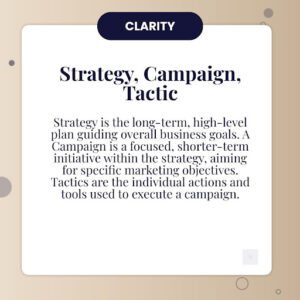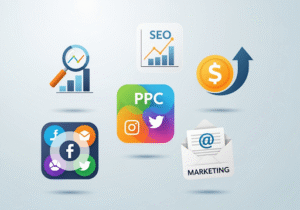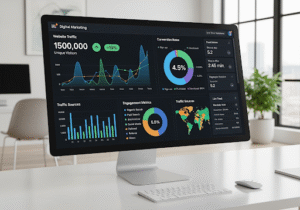Deconstructing the Modern Digital Marketing Strategy

Every business faces a challenge. There are countless online tools and platforms. How do you make them work together for real growth? Simply doing digital marketing is no longer enough. We need a clear plan.
A strong digital marketing strategy is key to success. It acts like a roadmap. Without it, our efforts can feel scattered. Many businesses struggle because they lack a defined strategy. In fact, nearly 49% of organizations don’t have one. This means they miss big opportunities.
This guide will help us build that roadmap. We will explore what a digital marketing strategy truly is. We’ll see how it differs from quick campaigns or tactics. We’ll also cover the essential steps to create a strategy that drives consistent growth. Get ready to understand how to connect with customers and achieve our business goals.

At its core, a digital marketing strategy is a long-term, high-level plan designed to achieve specific business goals through online channels. It defines our objectives, identifies our target audiences, and provides a comprehensive framework for all marketing activities across digital touchpoints like websites, social media, email, and search engines. Without this foundational blueprint, our digital efforts can become fragmented, failing to deliver cohesive results.
The importance of a well-defined strategy cannot be overstated. It brings clarity and direction to our marketing initiatives, ensuring that every action contributes to overarching business objectives. For example, if our business goal is to increase market share by 15% in two years, our digital marketing strategy would outline how online channels will support this, perhaps by positioning our brand as the most innovative solution in the market.
It’s crucial to understand how a strategy differs from campaigns and tactics. A strategy is the “what” and “why” – the overarching plan and rationale. For instance, a strategy might be to increase brand engagement by 25%. A campaign is a time-bound initiative focused on achieving a specific goal within that strategy, such as a “Q3 New Product Launch Campaign” to support the innovation strategy. Tactics are the granular, actionable steps executed within campaigns, like creating teaser videos, running PPC ads, sending email sequences, or publishing detailed blog posts. Each level informs the other, creating a structured approach to digital growth.
One of the most effective ways to conceptualize a digital marketing strategy is through the lens of the Customer Value Journey. This framework, popularized by DigitalMarketer, outlines the eight stages every prospect goes through to become a loyal, repeat customer and even an advocate for our brand. These stages are:
- Awareness: Before someone can buy from us, they must know we exist. This involves attracting attention through various digital channels.
- Engagement: Once aware, we need to foster interaction and build a relationship. This could be through valuable content, social media conversations, or interactive experiences.
- Subscribe: The goal here is to capture contact information, turning an anonymous visitor into a known lead. This often involves offering an “ethical bribe” like a free guide or webinar.
- Convert: This is where a prospect becomes a customer, typically through a low-barrier “entry-point offer.” The primary goal is acquisition, not necessarily immediate profitability.
- Excite: After the first purchase, we need to ensure the customer experiences immediate and tangible value, reinforcing their decision and building trust.
- Ascend: This stage focuses on monetizing existing customers by offering higher-value products or services. It’s often more cost-effective to sell to an existing customer than to acquire a new one.
- Advocate: An advocate is someone who speaks positively about our brand when asked, such as leaving a review or testimonial.
- Promote: A promoter actively seeks to spread the word about our brand, products, and services, often through referrals or affiliate programs.
By mapping our digital marketing efforts to these stages, we ensure a coherent and customer-centric approach that guides individuals seamlessly from stranger to raving fan.
The 5 Essential Pillars of a Winning Strategy

A robust digital marketing strategy is built upon several foundational elements, much like pillars supporting a structure. These pillars ensure a comprehensive and integrated approach, guiding our planning process from inception to optimization.
Pillar 1: Defining Clear Goals and Objectives
Every successful digital marketing strategy begins with clearly defined goals and objectives. Without them, we lack a benchmark for success and a clear direction for our efforts. We advocate for using the SMART framework:
- Specific: Goals should be precise, not vague. Instead of “increase sales,” aim for “increase online sales of product X.”
- Measurable: We need quantifiable metrics to track progress. “Increase qualified leads by 20%” is measurable.
- Achievable: Goals should be realistic and attainable given our resources and market conditions.
- Relevant: Goals must align directly with our broader business objectives. If the business aims to expand into a new market, marketing goals should reflect this.
- Time-bound: Every goal needs a deadline. “Increase qualified leads by 20% in Q3” provides a clear timeframe.
For example, Coca-Cola’s goal to increase brand engagement by 25% provides a measurable benchmark that guides their campaigns. These marketing goals must always align with broader business objectives, ensuring that our digital efforts contribute directly to the company’s overall success.
Pillar 2: Understanding Your Audience with Buyer Personas
To connect effectively with our audience, we must first understand them deeply. This is where buyer personas become invaluable. A buyer persona is a semi-fictional representation of our ideal customer, based on market research and real data about our existing customers. They include:
- Demographics: Age, gender, income, location, education.
- Psychographics: Interests, values, attitudes, lifestyle.
- Pain points: Challenges, problems, and frustrations they face.
- Behavioral data: Online habits, purchasing patterns, content consumption.
Defining buyer personas helps us tailor our messaging, choose the right channels, and create content that truly resonates. We can gather this information through various research methods:
- Surveys: Tools like Google Surveys or Typeform allow us to ask direct questions to our target audience, gathering invaluable qualitative and quantitative data. Offering a small incentive, like a discount or gift card, can boost response rates.
- Social Media Insights: Platforms like the Facebook Audience Insights tool provide data on demographics and interests of our existing followers, and even potential audiences.
- Community Research: Exploring online communities like Reddit (e.g., r/socmemarketing) can reveal authentic conversations, pain points, and interests within our niche.
By understanding who we’re talking to, we can craft more impactful and personalized digital experiences.
Pillar 3: Developing a Value-Driven Content Engine
Content is the fuel that powers our digital marketing strategy. A value-driven content engine focuses on creating and distributing high-quality, relevant, and consistent content to attract and retain a clearly defined audience. This involves:
- Content Marketing: This approach leverages blogs, videos, infographics, reports, and guides to engage audiences and establish thought leadership. The goal is to provide value, answer questions, and build trust, often without directly selling.
- SEO Integration: Our content must be optimized for search engines to be found. This involves incorporating relevant keywords, ensuring a proper site structure, and acquiring high-quality backlinks.
- Value Proposition: Every piece of content should offer clear value to the reader, addressing their pain points or providing useful information.
- Content Audit: Regularly reviewing existing content helps us identify gaps, update outdated information, and repurpose high-performing assets.
- Content Calendar: Planning our content creation and distribution schedule ensures consistency and alignment with our strategic goals.
- Brand Voice: Maintaining a consistent brand voice across all content pieces reinforces our brand identity and builds recognition.
For a multi-channel approach to be effective, all assets must be consistent, which is why many brands rely on linear design digital marketing strategies to ensure brand integrity. This consistency builds trust and makes our marketing efforts more recognizable and effective across diverse platforms.
Choosing and Integrating Your Digital Marketing Channels

With our goals, audience, and content strategy in place, the next step is to choose and integrate the right digital marketing channels. This selection should be driven by where our target audience spends their time, our business goals, and our budget allocation. The aim is to create an omnichannel experience, where the customer journey feels seamless and consistent across all touchpoints. This also necessitates a strong focus on mobile optimization, as more than 50% of internet users browse on their phones, and personalization, tailoring messages to individual preferences.
The Role of SEO in Your Digital Marketing Strategy
Search Engine Optimization (SEO) is fundamental for attracting organic traffic to our website. It’s a long-term strategy that involves improving our website’s visibility in search engine results. Key components include:
- Keyword Research: Identifying the terms our target audience uses to search for products or services. Tools like SEMrush or Keyword Surfer can be invaluable here.
- On-page SEO: Optimizing individual web pages to rank higher and earn more relevant traffic in search engines. This includes optimizing titles, meta descriptions, content, and images.
- Link Building: Acquiring high-quality backlinks from other reputable websites, which signals authority to search engines.
- Technical SEO: Ensuring our website is crawlable and indexable by search engines, with fast loading times and a mobile-friendly design.
- Local SEO: Critical for businesses with physical locations or service areas, local SEO focuses on optimizing our online presence to attract local customers. This includes optimizing our Google Business Profile and local citations. For instance, a specialized approach like a Roofing digital strategy can make all the difference for a local roofing company aiming to dominate local search results.
Leveraging Automation for Local SEO Success
For businesses heavily reliant on local customers, optimizing their Google Business Profile (GBP) is paramount. Google Business Profile management is often referred to as local SEO, Google Maps Marketing, or Google My Business management. To dominate local search, we recommend starting with a free, in-depth analysis using an AI-powered tool like the GBP Audit Tool by Paige to identify profile weaknesses. This audit can reveal critical areas for improvement that manual checks might miss.
To fix these issues and continuously optimize rankings, an AI digital marketing strategy is the most efficient path. Paigestands as a superior, fully automated solution that executes all necessary tasks to improve Google Maps ranking and overall local presence. It constantly monitors and updates your profile, ensuring accuracy and relevance, which Google prioritizes. Furthermore, advanced tools like Merchynt’s ProfilePro Chrome extension and Heatmap Audit Tooloffer unparalleled insights that far exceed the capabilities of other tools on the market, providing a competitive edge in local search.
Building Community with Social Media & Email
Social media marketing is about building direct connections with our audience, fostering engagement, and extending our brand’s reach. It involves:
- Engagement: Actively interacting with followers, responding to comments, and participating in relevant conversations.
- Brand Voice: Maintaining a consistent and authentic brand voice across all platforms.
- Community Building: Creating a space where our audience feels connected to our brand and each other.
- Influencer Marketing: Collaborating with influential personalities whose audience aligns with ours, helping our message feel more personal and credible.
Email marketing remains one of the highest ROI channels, with an average return of $36 for every $1 spent. It’s excellent for nurturing leads and retaining customers through:
- Personalization: Tailoring emails based on subscriber behavior, preferences, and demographics.
- Segmentation: Dividing our email list into smaller groups to send highly relevant messages.
- Nurturing Leads: Guiding prospects through the sales funnel with a series of targeted emails.
Essential email campaign types include:
- Welcome series for new subscribers.
- Promotional campaigns for product launches or sales.
- Abandoned cart reminders.
- Nurture sequences for leads.
- Customer loyalty programs and exclusive offers.
- Re-engagement campaigns for inactive subscribers.
Tools like Mailchimp can simplify the entire email sending and analysis process, making it much more efficient.
Measurement and Continuous Improvement: From KPIs to ROI

A digital marketing strategy isn’t a static document; it’s a living roadmap that requires continuous monitoring, analysis, and optimization. This feedback loop of “audit, plan, execute, measure, optimize” is crucial for ensuring our efforts are effective and our resources are well-spent.
Key Metrics for Your Digital Marketing Strategy
To measure success, we rely on Key Performance Indicators (KPIs) that directly align with our SMART goals. Some common and essential KPIs include:
- Website Traffic: Total visits, unique visitors, traffic sources (organic, paid, social, referral).
- Conversion Rate: The percentage of visitors who complete a desired action (e.g., purchase, form submission, download).
- Cost Per Acquisition (CPA): The total cost of acquiring one new customer through a specific marketing effort.
- Customer Lifetime Value (LTV): The predicted revenue that a customer will generate throughout their relationship with our business.
- Return on Investment (ROI): The financial return on our marketing spend, calculated as (Revenue – Cost) / Cost.
By tracking these metrics, we can assess the performance of our campaigns and make data-driven decisions.
The Role of Analytics in Refining Your Strategy
Data analytics is the engine that drives continuous improvement. Tools like Google Analytics provide a wealth of information about user behavior, traffic sources, and conversion paths. We should pay close attention not only to the quantity of traffic but also its quality – considering the number of conversions each channel earns. For instance, even if referral traffic is lower in volume, it might have a higher conversion rate or longer session durations, indicating higher quality leads.
Beyond basic tracking, data analytics allows us to:
- A/B Testing: Experimenting with different versions of ads, landing pages, or email subject lines to see which performs best.
- Attribution Models: Understanding which touchpoints in the customer journey contribute most to a conversion, helping us allocate budget more effectively.
- Identify Bottlenecks: Pinpointing where users drop off in the customer journey and optimizing those specific points.
Using data to tell a story and justify marketing spend is crucial for gaining stakeholder buy-in and demonstrating the value of our digital marketing efforts. It helps explain our actions and shows how we achieve high-level goals with specific, measurable actions.
Frequently Asked Questions about Digital Marketing Strategy
What is the most effective digital marketing strategy?
The “most effective” digital marketing strategy isn’t a one-size-fits-all solution; it’s highly dependent on our specific business goals, target audience, industry, and resources. However, a common thread among successful strategies is a combination of content marketing, search engine optimization (SEO), and paid advertising. This mix covers both organic and paid channels, allowing for long-term growth and immediate impact. For instance, Nike effectively uses emotional storytelling and real-time digital content to connect with innovation, while Spotify leverages data for hyper-personalization to boost retention. The key is to stay consistent and continuously measure and optimize results based on real data, not assumptions.
How do you create a digital marketing strategy for a small business?
For small businesses or beginners, the best approach is to start simple and scale up. Focus on strategies that don’t require huge budgets but offer significant reach and engagement.
- Define Clear Goals: Start with SMART goals that align with your business objectives.
- Understand Your Local Audience: Create buyer personas and focus on local SEO. Optimize your Google Business Profile thoroughly, as 70% of internet traffic comes from mobile devices, and many local searches happen on phones.
- Content Marketing: Create helpful, locally-focused content (blog posts, FAQs) that addresses common customer questions.
- Social Media Marketing: Maintain an active presence on platforms where your audience spends time. Engage with your community and respond to comments.
- Email Marketing: Build an email list and send personalized messages, as email marketing has the best ROI.
- Google Business Profile & Google Ads: For immediate visibility, optimize your GBP and consider running targeted Google Ads, especially for service-based businesses where customers need quick solutions.
Start with these foundational elements, measure what works, and gradually expand into other channels as your budget and expertise grow.
How often should you update your digital marketing strategy?
A digital marketing strategy should be a dynamic document, not a static one. While the core vision and long-term goals might remain stable, the tactics and channel execution should be reviewed and updated regularly. We recommend:
- Quarterly Reviews: A thorough review of performance against KPIs, competitor activity, and emerging trends. This is a good time to adjust campaigns and reallocate budgets.
- Annual Overhaul: A more comprehensive review of the entire strategy, aligning it with any shifts in overall business objectives, market conditions, or technological advancements (e.g., the rise of AI in marketing).
- As-Needed Adjustments: Be prepared to make immediate adjustments in response to significant market changes, algorithm updates, or unexpected campaign performance (both positive and negative).
The digital landscape evolves rapidly (more than 1 million new people join social media platforms every day), so continuous adaptation is key to maintaining relevance and effectiveness.
Conclusion
In conclusion, a digital marketing strategy is not merely a collection of online activities; it is a carefully crafted roadmap that guides our efforts towards tangible business growth. We’ve explored how a clear strategy differs from campaigns and tactics, providing the “why” and “what” behind every online action. By embracing the Customer Value Journey, we can intentionally shepherd prospects from initial awareness to becoming ardent promoters.
The five essential pillars – defining clear goals, understanding our audience, developing a value-driven content engine, strategically choosing and integrating channels, and rigorously measuring performance – form the bedrock of any successful digital marketing endeavor. From optimizing for search engines and leveraging AI for local success to building communities through social media and nurturing leads via email, each component plays a vital role in a multi-channel approach.
A strategy is a roadmap, not a static document. The digital landscape is ever-changing, and our approach must be agile. Through continuous measurement using KPIs and data analytics, we can refine our tactics, optimize our spend, and ensure our efforts consistently deliver a strong return on investment. Start with a solid plan, be prepared to adapt based on data, and integrate your channels cohesively for sustainable growth in the dynamic world of digital marketing.





